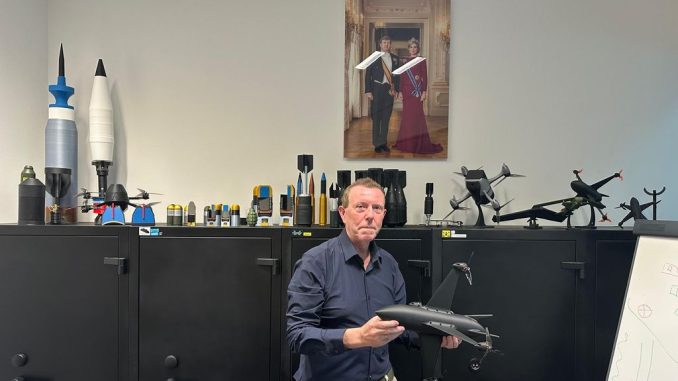
Extra billions for Defense: manufacturers scales on, start-ups also in the race
“Look, I do it for this.” With a smile, Gerard Zondervan, director of Artillery Institutions Armaments, shows a photo of one of his grandchildren. Zondervan has boarded the defense industry to keep the Netherlands – and its offspring – safe. There is a NATO flag at the gate of his Tilburg company. Camera surveillance, heavy fences, but no drone or grenade is made yet.
That must change within a few months. The machines to produce drones have been ordered. It is both about drones to carry out attacks and about drones to defend. At the end of this year a few hundred people have to work in the brand new factory hall.
“You buy the artillery lovers from the old weapon producers. They remain important. Tens of thousands are still being shot,” says the weapon manufacturer. “On the other hand, you can just see that the unmanned work is taking an ever -increasing share in the fight.”
“No shortage of money and assignments”
Part of the drones that Zondervan wants to produce goes to Ukraine. AI Armaments hopes to benefit from the extra money that NATO needs to increase the defense capacity of the alliance.
The new standard of 3.5 percent of GDP for Defense, plus one and a half percent for increasing the resilience of society – a total of five percent – must be settled at the NATO top in The Hague at the end of this month. On Friday, the outgoing cabinet decided to increase defense spending by 19 billion euros, to meet that new standard.
“No shortage of money and assignments,” says Zondervan, but a place to work with explosives and find the right people to make ammunition is a different story, “with ASML around the corner, which fishes in the same pond”. Yet, he says, spontaneously report people who want to get started with him.
Fireworks disaster
In a densely populated country such as the Netherlands and, for example, the fireworks disaster of Enschede in mind, it is not easy to find a suitable place for the production of drones and grenades. But Zondervan sees change. “We just notice that municipalities approach ourselves instead of the other way around.”
Zondervan states that the realization has penetrated that everyone has an interest in defense. With which municipalities the entrepreneur talks, he does not want to say, “not to disturb the process”.
Another problem lies with the banks, says Zondervan. “If they hear that it is about weapons, they want to close your account rather than open.”
He says about ‘dual use’ products, which both have a civil and military application, he says. But most financiers keep the door closed when it comes to, for example, a Kamikazedrone, of which Zondervan wants to make thousands.
Existing producers do not have those problems. An expert like General Buiten Dienst Mart de Kruif therefore thinks that it is best to scale quickly at the companies with which the Ministry of Defense already works. Consider, for example, the German Rheinmetall, the producer of the Leopard tanks and the Boxer, a slightly armored infantry vehicle, which is assembled in Ede.
The director of Rheinmetall Nederland, Coen van Leeuwen, says to Bnr, that Ede has room to scale up. But Zondervan thinks that Defense will encounter full order books with the great German weapon producer. He speaks of “a ten -year waiting list”.
For arms manufacturers, the most important customer is the Ministry of Defense in the Netherlands. “The buyers of the Ministry always wanted to have the best product for the best price,” says strategy consultant Nick Hageraats van Berenschot. “Taking the right steps and making a well -considered choice was central to that, not speed.” That changes, he says. “The emphasis on speed, larger numbers and more money, requires a different way of working. That needs time.”
‘Syrupy procedures’
Manufacturer Zondervan gives an example of “syrupy procedures”: for the introduction of new ammunition, with all tests, five to seven years. “Who knows where we are,” says the entrepreneur, who has a 3D-printed grenade on his desk.
He points to the technological developments on the battlefield in Ukraine: “They cannot be kept up to date. The existing companies do not have that knowledge either. We have to do it themselves, gather the knowledge ourselves,” he says, standing in a large cage where Drones will make test flights.
For new weapons you end up with start-ups such as his, Zondervan hopes.

Be the first to comment